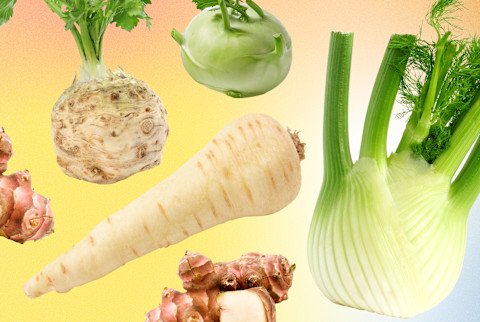5 Weird Fall Veggies That You're Not Eating But Should Be

While we love pumpkin as much as the next person, there are other veggies that are worth paying attention to when the leaves start to change and the air gets crisp (besides, pumpkin is technically a fruit!). Fall is a harvest season, when a bounty of fun and flavorful vegetables fill the shelves at grocery stores and the farmers market. Make your plate healthier and more delicious by incorporating some of these more out-there pieces of produce into your meals:
1. Parsnips
Parsnips are often overlooked in favor of carrots or sweet potatoes, but they offer a ton of flavor and versatility. They have a toasted nutty flavor and a starchy texture that works well in most root veggie recipes. Look for parsnips that are heavy for their size, full, and plump, avoiding any twisted or dried ones. I love to use parsnips to make a more interesting version of mashed potatoes (just boil them in well-salted water, then rough-mash with a milk of choice—coconut adds a lovely sweetness). They're also great in fritters or sliced thinly to make chips, which you can then coat with any seasonings you'd like. Parsnip fries, made by slicing them thinly and roasting at 400 degrees with salt and olive oil until brown, are also a delightful fall side dish, especially tossed with some flaky sea salt and fresh chopped rosemary.
2. Kohlrabi
Ah, kohlrabi, the staple of CSA boxes everywhere. Many people are intimidated by kohlrabi, which is purple with strange, alien-like arms growing off of it. It's a descendant of wild cabbage, and it's actually incredibly versatile. It has a fresh, subtle flavor (like a less spicy radish) and is able to be eaten cooked or raw. If you go the raw route, peel your kohlrabi and cut off any knobby bits, then slice it thinly to use in a salad or a heartier slaw. If you'd like to cook it, you can leave the peel on. Just cut off any knobby parts, and roast it like you would potatoes, or mash it as per the parsnip recipe above. Because it has such a mild flavor, kohlrabi is best accompanied by plenty of spices and seasonings—it's often found in Indian cuisine, and plays well with bold curry-type spices.
3. Fennel
Fennel, a member of the parsley family, is a wonderful way to add a ton of flavor to fall dishes since every part of the plant can be eaten—and every part offers a totally different texture and flavor profile. The white bulb can be eaten raw or roasted—I love the lightly anise-like flavor it adds when mixed in with a more traditional blend of sweet potato, butternut squash, and Brussels sprouts. It also plays well with onion and can be sautéed quickly with it, then blended with vegetable stock to make an easy, warming fall soup. The green, airy fronds taste like fresh anise and are wonderful for finishing a dish—they elevate the flavor and texture of either of the ones mentioned above (and almost any dish with fennel bulb at its base), and you'd be helping eliminate food waste in the process.
4. Jerusalem artichokes
I don't like to play favorites, but Jerusalem artichokes just might be my vegetable of choice. Also called sunchokes, they're a type of root vegetable (and they aren't at all related to traditional artichokes). They're a potent source of inulin, a prebiotic fiber that's good for cultivating gut bacteria, but this is also why you need to be a bit careful with them. Because of all that inulin, eating them raw can cause digestive distress, and eating a lot of them in one sitting (especially if you haven't been filling up on that recently) can essentially cause a feeding frenzy in your microbiome, causing you to get a little gassy and bloated. The good news? If you eat them in relatively small quantities, cooked, you're in for one of the most delicious veggie experiences on the planet. Sunchokes are buttery, nutty, and savory—like a normal white potato with its flavor amped up by a thousand. Scrub 'em well and then cook them like you would new potatoes, in soups, roasted, or even in a gratin.
5. Celery root
Celery root is, as you might expect, the root of the celery plant. It has a brown, hairy exterior that can be intimidating (and you should always peel it—never eat that part!), but inside, there's tender white flesh that's incredibly delicious. It can be thinly sliced or chopped into matchsticks and eaten raw (a common French preparation), a preparation that helps showcase the most celery-like flavor. If you want to eat it cook, treat it like you would any other root veggie—once it's peeled, it can be roasted, made into a soup, or mashed like a potato. The celery flavor is less pronounced when it's cooked, although it's still present, so pair it with flavors that would go well with celery—think raisins, parsley, lemon, or mustard.
